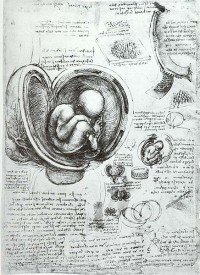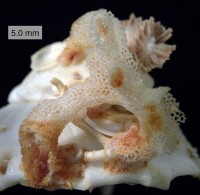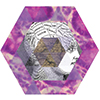
Dicyema erythrum (Phylum Dicyemida) (Image: Used with the kind permission of Professor Hidetaka Furuya)
Yes, of course
Odd sort of question, if I may say. Now then, animals (grown-ups call them Metazoa) certainly evolved from the protistans (which in the old days were named Protozoa), but so far as the former are concerned their nearest chums go by the name of choanoflagellates. Yes, these are protistans and belong to an enormous group (the unikonts if you need to know, more or less meaning “single flagellum”) that happens to include amoeba. But the relationship between any animal and an amoeba is pretty remote. So no traction here. Maybe you were thinking of size? Certainly animals as tiny as an amoeba are known. Please step forward those masterpieces of miniaturization in the form of tiny insects that fly using a comb and have brains the size of a human neuron. Yet despite their Lilliputian status not only are they fully functional, but the economy of construction can be mind-boggling.
In this context consider a marine group known as the cycliophorans. Here the males are dwarfed (not as rare as you might think) and at 40 μm in length are twice as small as any arthropod. But are the boys correspondingly simplified? Not a bit of it! With a hundred cells or less, they still construct a complex body, complete with nervous system, muscles and those all-important gonads. No traction here either. Alright, what about the parasites known as the myxozoans? Never heard of them? You certainly would if you were running a fish-farm where they are a major scourge and induce unpleasantness in fish such as whirling disease. Certainly myxozoans are very protistan-like. But parasitism plays strange tricks on animals and all the evidence points to myxozoans actually being derived from jellyfish and cleverly redeploying the iconic stinging cells (the nematocysts) as attachment devices to grasp the host tissue. So we don’t seem to be any closer to making an animal into any sort of protistan, do we?
No, don’t be ridiculous
Think again! Consider the mesozoans. How did they come by their name? Good question, because for a long time they were thought to represent a half-way house between the Metazoa and Protozoa. In fact they are not only animals, but belong to a group (in the trade known as the lophotrochozoans) that includes the squid and octopus (cephalopods). And that is where you need to go to find mesozoans, where they form dense thickets on the surfaces of the kidneys. Despite retaining genes like Pax-6 (that help to make the camera-eyes of their hosts), the mesozoans have made a very fair stab at turning themselves into protistans. The body is hugely simplified, with no trace of a gut or nervous system but consisting of about 40 cells equipped with beating cilia and a unit that allows them to attach to the kidney. But it gets better because whilst bottom-dwelling cephalopods play host to these fake protistans, the kidneys of their swimming counterparts are infested with remarkable look-alikes but these are the genuine article in the form of ciliates (belonging to the chromidinids).
It all depends on the question
Spending a life drenched in octopus urine may seem a pretty short straw, but mesozoans provide object lessons to keep any biologist happy. First, despite their apparent simplicity they have an engagingly complex life-cycle and a nifty way of constructing their sperm that breaks all the rules. Next object lesson is their convergence with the protistan ciliates. This extends to a similarity not only of body shape, but mode of attachment and life cycle. All this suggests that if you are going to spend a life thrashing around in octopus pee then there is only one way to do it. Then there is the question: are they just parasites or actually favoured symbiotic guests? The latter appears to be the case, but there is a further intriguing thought. In many ways squid and their relatives are honorary fish and are connected by all sorts of convergences that go far beyond the famous example of the camera-eyes. But a cephalopod bodyplan imposes limitations, and in principle a fish kidney outstrips the squid equivalent. Maybe, however, the mesozoans (and their ciliate counterparts) play a vital role in the excretory process, assisting with fluid flow and dealing with the waste products?
Text copyright © 2015 Simon Conway Morris. All rights reserved.
Further reading
Aruga, J. et al. (2007) Dicyema Pax6 and Zic: tool-kit genes in a highly simplified bilaterian. BMC Evolutionary Biology 7, e201.
Czaker, R. (2011) Dicyemid’s dilemma: structure versus genes. The unorthodox structure of dicyemid reproduction. Cell and Tissue Research 343, 649-658.
Furuya, H. et al. (2004) Renal organs of cephalopods: A habitat for dicyemids and chromidinids. Journal of Morphology 262, 629-643.
Holland, J. W. et al. (2011) A novel minicollagen gene links cnidarians and myxozoans. Proceedings of the Royal Society of London, B 278, 546-553.
Huber, J.T. and Noyes, J.S. (2013) A new genus and species of fairyfly, Tinkerbella nana (Hymenoptera, Mymaridae), with comments on its sister genus Kikiki, and discussion of small size limits in arthropods. Journal of Hymenoptera Research 32, 17-44.
Kobayashi, M. et al. (2009) Molecular markers comparing the extremely simple body plan of dicyemids to that of lophotrochozoans: insight from the expression patterns of Hox, Otx, and brachyury. Evolution & Development 11, 582-589.
Nesnidal, M.P. et al. (2013) Agent of whirling disease meets worm: Phylogenomic analyses firmly place Myxozoa in Cnidaria. PLoS ONE 8, e54576.
Neves, R.C. (2009) Cycliophoran dwarf males break the rule: High complexity with low cell numbers. Biological Bulletin 217, 2-5.






